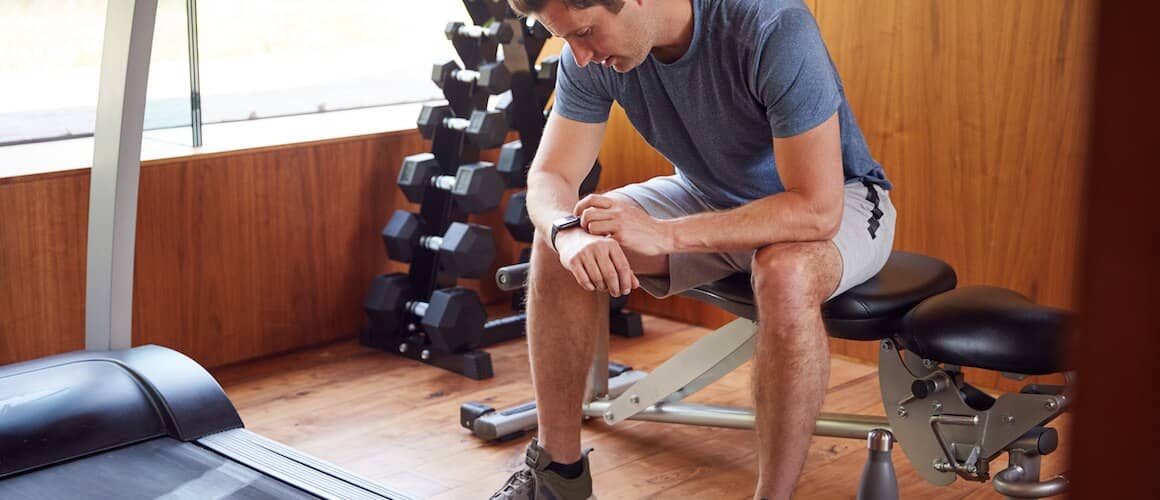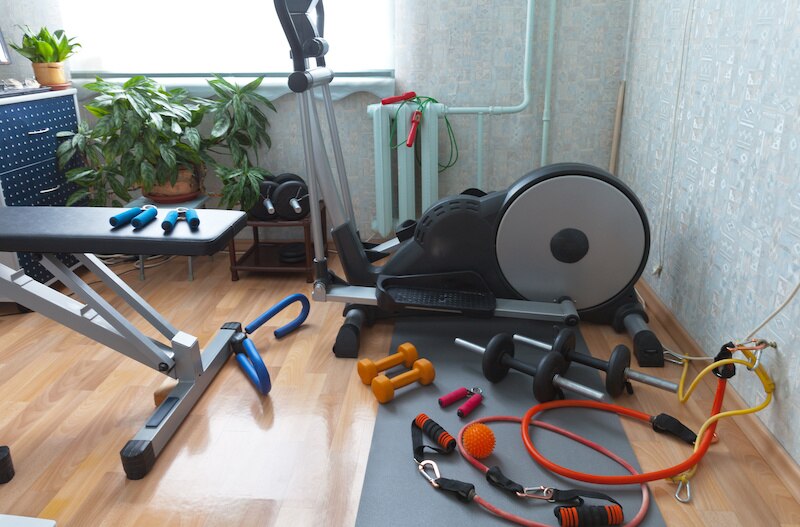
How To Build A Home Gym For Your Budget
5-Minute ReadUPDATED: May 20, 2022
The global pandemic has challenged us to think differently about crowded gyms and communal workout spaces. And with winter weather approaching fast, you may be wondering how you’ll be able to keep up your fitness routine while staying a healthy distance from others.
We’ve discovered that at-home workouts have become a popular gym-distancing solution, but do you have the right exercise gear and setup to reach your long-term fitness goals? Here, we’ll discuss the basics for building your very own fitness gym at home and solutions when it comes to cost.
Home Gym Advantages
There are many pros when it comes to building a home gym vs. buying a gym membership. At first, it can feel tough to separate your everyday home mentality from your gym mentality. But that’s why having the right equipment and dedicating a specific space to fitness can help boost the inside transition and get long-term results.
It’s Personalized
Not only does a home gym limit your overall preparation and transportation time, but it’s simply easier to integrate into your day.
With you in charge of building the space, you really get to personalize the entire workout experience. You can exercise whenever you want (perhaps midnight inspiration?) to ensure workout efficiency, with lines for equipment.
It’s Private
At home, privacy is easy to find. Many beginners can feel pressured when attending a professional gym setting. A secluded space gives you the freedom to work out at your own pace and confidently explore different workout approaches. It also creates a safe space where you can sing, blast your music or scream out in frustration – not worrying about acting inconsiderate to others on the gym floor.
It’s Cost-Effective
Buying equipment may feel expensive at first, but it saves overtime compared to the ongoing cost of a gym membership. And your home gym can last for years depending on your choice of high-quality equipment. There are also easy ways to handle any upfront costs that it takes to get you started.
What Fitness Equipment To Buy
Depending on your workout routine, some exercise equipment makes more sense to buy than others. Learn what items you may want to consider as you piece your gym together:
For The Inner Yogi
There are items to keep in mind as you practice mindfulness and improve flexibility. Creating a yoga corner in your home gives you the opportunity to surround yourself with yoga and make it a bigger part of your natural lifestyle.
Here are some props for a successful at-home yoga experience:
- Yoga mat
- Yoga bolsters
- Yoga blocks
- Yoga blankets
- Meditation cushions
- Light and open window spaces
For The Marathoner
Runners and those working on improving their endurance levels should buy equipment that is more running, recumbent bike or elliptical-focused. The equipment should give you control by providing settings for ascending and interval training.
Some options and recommended gear include:
- Treadmill
- Jump rope
- Free weights (for cross training)
- Plyo box / Plyometric box
- Hanging punching bag and gloves
- Medicine ball
- Muscle foam roller (for post-workout)
For The Body Builder
There are many great gym tools when it comes to strength and muscle building practices. And customizing your home workouts for your current and ideal body type is very important.
When it comes to body building, make sure that you are thinking about today and tomorrow. As you build up your muscle and confidence, you’ll want to have extra weights to add to your sets. That’s why variety is so important when pairing weight options with your machines.
Here are some items to consider for your muscle workouts:
- Squat / power rack
- Olympic barbell and weight plates
- Adjustable bench press
- Leg press machine
- Rowing machine
- Barbells and weight set
- Weight bench
- Pull up bar
- Cables and pulleys
- Medicine ball (for core)
- Muscle ropes
- Weighted vest
- Squat belts and safety gear
For The Gym Generalist
Keep in mind that having a connect home gym look and feel is important, especially when it comes to learning your equipment.
If you fall into a blend of the categories above (or don’t know which suits you best), consider giving yourself a cohesive "gym starter kit" to get going and see where your fitness journey leads.
Here are the basics when it comes to creating a solid gym foundation:
- Yoga mat
- Treadmill
- Hand weights & kettle balls
- Medicine ball
- Jump rope
- Push up stands
- Foam roller
- Whiteboard (for marking your progress!)
Other Home Gym Needs
Regardless of what exercises you perform or what your energy level is, there are other things asides from the equipment that you may consider using in your home gym space:
- Proper gym flooring
- Floor matts
- Mirror wall
- Laptop or television to play instructed workouts
- Dumb bells and light weights
- Resistance bands
- Music stereo

How To Build A Home Gym
1. Set Aside Space
Like any home renovation you need to think about your living situation and the kind space it provides. You will want as much space as possible for your home gym, ideally a place with limited distractions, separate from the hustle and bustle around your home.
But if you don’t have an entire room to set aside for your gym? No problem. Find a corner or area that help you to focus and stay motivated. This could be near a window, house plants or inside your garage.
2. Measure Your Space
After you secure a spot, make sure to measure it! Know sizing helps understand the type (and amount) of equipment you’ll have room for vs. buying something that doesn’t optimize the space.
3. Consider Your Workout Goals
Think about your workout plan. What do you want to accomplish, and what equipment will you need to reach your goals? This will help personalize and prioritize your home gym experience.
4. Map Out Your Home Gym Set Up
Now that you know what you’re aiming for, think about how best to optimize your chosen workout space. Take your space measurements, equipment preferences, and sketch out a floor plan. Remember to include any storage needs and make sure you have enough electrical sockets in the area – or consider purchasing an extension cord.
5. Install Any Storage Needs
Install necessary gym shelves or cubbies and purchase bins for any jump ropes, kettle bells or smaller items. If you have a dumbbell set, make sure you have a rack where you can safely organize them by weight.
6. Shop Fitness Equipment
After you understand what can and cannot fit into your home gym space, now is the time to purchase the right fitness equipment. Keep your goals in mind and make sure to compare costs when it comes to fitness brands. You will definitely want to consider your equipment quality to find a balance between long-term use vs. cost.
7. Personalize Your Gym Space
The most important thing about building a home gym is that you want to feel motivated to keep using it! Once you have your equipment and workout plans in order, think about what pushes you to carry on your personal fitness journey – inspirational posters, great lighting, television, a large whiteboard to track progress, etc.
Ways To Finance Your Home Gym
Let’s help take away any financial pain when it comes to your home gym gains. There are many ways to pay for building your home gym. Let’s take a quick look at what they are:
Savings Account
A popular way to pay for any major lifestyle expense is simply to work and save for it. Create a bank account where you can set aside and deposit “x” amount of your monthly income. That way, you can easily manage and build toward your dream gym over time.
Personal Loan
A personal loan helps pay for everything your home gym needs upfront, and then has you make fixed, monthly payments over time – with interest. Most personal loans have a starting amount of $2,000, which can work well with any personal gym equipment costs (treadmill alone can easily cost $3,000).
Learn how you can qualify for a personal loan here.
Credit Card
A credit card is another way that you can pay upfront for your home gym costs. Credit cards normally give you a spending limit based on your income and credit score, and can offer reward benefits for certain dollars you spend. However, keep in mind that a credit card may have a higher interest rates than a personal loan, risking uncontrolled, credit card debt.
Trying to understand the difference between a personal loan and credit card? Click here.
Specific Tips To Cut Costs
Buy Used Equipment
Do your research and visit resale sites like Facebook Marketplace and Craigslist to find good deals on used gym equipment. You can also check out local garage sales in your area. Make sure you test out any used equipment before you buy and bring it home to ensure things works properly.
And if you can’t buy used, consider buying from one retailer to save on shipping costs.
Consult Fitness Experts
You may not have the time in your day (or knowledge!) to understand what equipment is right for you. Luckily, fitness experts can step in as your guide and let you learn from their own mistakes and preferences. You can ask a more experienced friend, read a fitness blog or even ask a trainer at a local gym what they recommend.
Build For Your Goals
Above all, think about what is sustainable and works best for you. Avoid the gym equipment that doesn’t make sense for what you’re building for i.e. don’t get a pull up bar if you know you’ll never enjoy or use it.
Final Thoughts
It’s time to build toward something great while you’re stuck staying safe at home. A home gym could be the perfect, self-care investment to help motivate and achieve your goals this winter.
And when it comes to building a gym, consider the materials and financing methods available to make your home gym work best for you.
Apply For A Personal Loan.
Working On A Home Project?
Use a personal loan to finance exactly what's needed for turning your house into a home.
See My OffersRelated Resources
Viewing 1 - 3 of 3

